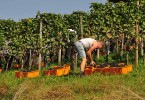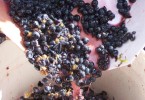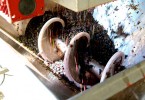Discovering rosé wines
We want to dispel an unpleasant myth: rosé wines are neither secondary wines nor obtained through the mixing of white and red wine. Nothing worst than thinking that the colour of the delicate rosé shades is obtained in this way: rosé wines have a particular making process and they are born with the precise idea of having that rosé colour.
Both if they are Spumante and still wines, rosé wines have been underestimated for years, but now they are having a come back gaining again a great appreciation.
From Montepulciano d’Abruzzo Cerasuolo to Chiaretto del Garda Veneto, rosé wines hide pleasant surprises for the tasting buds and are perfect wines to be paired with delicate and savoury dishes.
How is Rosé wine produced?
The big family of rosé wines enclose, actually, wine produced with different techniques. Two rosé wines thus can be produced with two different methods even if the result is similar both under a visual and organoleptic point of view.
All the methods have a common element: the rosé wines are obtained from red grapes; the only exception is some Spumante wines with starting cuvee foresees a mix of white and red grapes.
How does the production of rosé wines take place? The first phases are typical of the red wines ending with the traditional making process of the white wines. The main difference between the two wines is given by the maceration of the grapes: red wines, on the contrary of the white wines are subjected to a long maceration of the pulp together with the peels, main responsible of the colour of the wine. Besides the colour, the grapes release also tannins, aromas and antioxidants polyphenols, completely absent in the white wines.
How is the rosé colour obtained?
The must macerates with the peels for a period that can vary between few hours up to a maximum of two days. In this way the liquid take a colour with pink shades and then, once divided the must from the peels, the next step is the production process typical of the white wines.
Maceration of rosé wines
To be more precise, however, the maceration can take place in two different methods and timing. Each of them produces a different rosé wine, named based on the chosen maceration technique. Wines are divided into:
- Vin gris (grey wine): with a light pink colour, these wines are obtained from grapes with a weak colouring ability. The light colour that characterised them is released during the pressing but the maceration of the must in the peels doesn’t take place.
- Blush wines: it is a technique similar to the vin gris, these rosé wines with a light colour are typical of the United Stated, with a white vinification achieving their typical colour during the pressing.
- One-night wines: when the maceration process of the must in the peels lasts between 6 and 12 hours.
- One-day wines: when the maceration lasts around 24 hours.
- Saignée: a little must is taken during the maceration of red grapes to make a white vinification.
After the maceration, the vinification process continues as usual for the white wines. Then, the fermentation take place and once matured, wine rests in steel tanks and containers. After being stabilized and filtered, wine is bottled and it is ready to be traded.
Perfect pairings with the rosé wines
Rosé wines are similar to the red wines for their appearance, but actually their taste is pretty closer to the white wines. Their organoleptic characteristics consist in a fruity perfume of red fruit and floral notes that remind the violet and spring coloured flowers. In the mouth they are fresh and well balanced, without the strong personality and the marked taste of the red wines.
The perfect pairings enclose thus, not too fat and savoury dishes rather simple preparations, tending to sweet and sapid with an average fatness. A good rosé wine is perfect with first courses with vegetables, starters with seafood, white meats, salmon and desserts with fruit and cream or creamy cakes.








